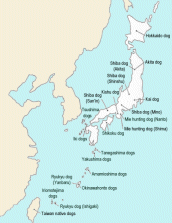 Prof. Tanabe in 1991 analysed ten of eleven native Japanese breeds (see map):
Prof. Tanabe in 1991 analysed ten of eleven native Japanese breeds (see map):
|
The origins of the Japanese dogs and the colonisation of the archipelago |
The dog is one of the few domestic animals, which, since pre-agricultural time, has lived with man in a partnership from which both mutually profited. That means the dog was not solely a source of food and raw materials as with the so-called probiosis (commensalism) where just one side takes advantage, even though the other suffers no adverse effects. Man and dog rather lived in symbiosis and formed a hunting team, in which each benefited from the partner's skills.
The dog (Canis familiaris) was domesticated between 14 and 12 thousand B.C. Since then the dog accompanied man on his way to colonisation all over the world. And so he also accompanied the migrants who first colonised the Japanese islands. These dogs who came to Japan together with the first settlers are the ancestors of the different contemporary breeds.
Every human or animal individual has a genetic "fingerprint" by which he can be identified. The genetic term is polymorphism ("multiple forming"), meaning the variations (mutations) of a specific gene within the same locus. These variations can be condensed to an unequivocal pattern and again these patterns can be assigned to a larger group, e.g. the genetic patterns of dogs to a local breed. The more crossbreeding takes place, the greater is the variability of genes.
The genetic patterns of individual breeds reveal a genetic relationship over spatial distance. If similar patterns in different localities can be verified, migration movements from one place to the other can be assumed. With a large degree of certainty this can also be said to apply to long periods of time and over wide areas. The genetic term used in this context is geographical gene flow.
In Japan the geneticist Yuichi Tanabe, professor emeritus at Gifu University, has reconstructed the colonisation of the archipelago on the basis of the gene flows of the native Japanese breeds. For this purpose he examined the blood protein polymorphism of more than 3,600 European and Asian dogs from 40 breeds using biochemical analysis.
 Prof. Tanabe in 1991 analysed ten of eleven native Japanese breeds (see map):
Prof. Tanabe in 1991 analysed ten of eleven native Japanese breeds (see map):
| – | Hokkaido (Ainu) (picture) |
| – | Akita (picture) |
| – | Kai (picture) |
| – | Kishu (picture) |
| – | Shikoku (picture) |
| – | Ryukyu (Yanbaru and Ishigaki) |
| – | Shiba with four local varieties: Shinshu, San'in, Mino and Akita Shiba (Jomon Shiba) |
| – | in the Ryukyu or Nansei Islands between Japan and Taiwan: Tanegashima, Yakushima, Amamioshima, Okinawahonto and Iriomotejima |
| – | in the two islands between Japan and Korea: Iki and Tsushima |
| – | in the Shima and Kishu peninsulas: the Mie hunting dogs (Shima and Nanto) |
Altogether the blood protein gene patterns of 1,556 indigenous Japanese dogs were analysed. The patterns of these were compared with those of dogs from Taiwan, Korea, China, Europe, Russia and Bangladesh. As a result, a close genetic relationship appeared between the Japanese native dogs in Ryukyu, Hokkaido, Okinawa and the Taiwan native dogs; and also between the dogs in mainland Japan and the Korean native dogs.
The results, considered together with the evidence from further archaeological studies, imply according to Prof. Tanabe that the Japanese dogs came to Japan from two directions some thousand years ago:
| – | the first wave brought by the Jomon people from somewhere in Southeast Asia including Taiwan and South China 8,000-9,500 years ago and spreading over all areas of the country; |
| – | the second wave from the Northwest through the Korean peninsula 1,700-2,300 years ago by the Yayoi migrants. |
Most modern-day Japanese dogs can be considered to be descendants of the crossbreeds of these two types of dogs, although the genetic dispositions of the Hokkaido and Ryukyu dogs (see pictures) still seem to be rather uninfluenced.
The studies were continued later on by Prof. Tanabe and other Japanese scientists, using more than 5,000 dogs and including a still wider settlement area. Thereby the results of 1991 could be validated and rendered more precisely. In these new analyses of Japanese dogs the Mikawa dog was taken into account also. It was also ascertained that the Shiba shows the lowest genetic variability.
The studies of Prof. Tanabe and colleagues were published in the following scientific journals: